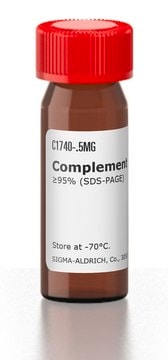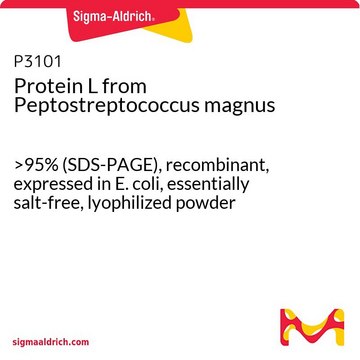204876
Complement C1q, Human
Complement C1q, Human, CAS 80295-33-6, is a native C1q complement component composed of 18 polypeptide chains consisting of three nonidentical A, B, C subunits of 29, 26, and 19 kDa, respectively.
Sinónimos:
Complement C1q, Human
Iniciar sesiónpara Ver la Fijación de precios por contrato y de la organización
About This Item
Productos recomendados
Nivel de calidad
Análisis
≥90% (SDS-PAGE)
formulario
liquid
fabricante / nombre comercial
Calbiochem®
condiciones de almacenamiento
OK to freeze
avoid repeated freeze/thaw cycles
impurezas
IgG, IgA, IgM, C3, C4, albumin, fibrinogen, α₂-macroglobulin, trace
Condiciones de envío
wet ice
temp. de almacenamiento
−70°C
Descripción general
Native, human C1q complement component. Glycoprotein composed of 18 polypeptide chains consisting of three nonidentical subunits A, B, and C, of M.W. 29,000, 26,000 and 19,000, respectively. Present in normal human serum at 70 µg/ml. Found in circulating blood plasma complexed with two C1r and two C1s molecules to form the first component of complement (C1). Activation of complement via classical pathway is triggered by binding of C1q to immune complexes containing IgG or IgM or to a variety of other activating substances, including C-reactive protein, retroviruses, and mitochondria. Subsequent to C1q binding, C1r and C1s are converted to proteolytic enzymes that are responsible for continuation of activation via the classical pathway.
Native, human C1q complement component. Glycoprotein composed of 18 polypeptide chains consisting of three nonidentical subunits, A, B, and C, of M.W. 29 kDa, 26 kDa, and 19 kDa, respectively. Present in normal human serum at 70 µg/ml. Found in circulating blood plasma complexed with two C1r and two C1s molecules to form the first component of complement (C1). Activation of complement via classical pathway is triggered by binding of C1q to immune complexes containing IgG or IgM or to a variety of other activating substances, including C-reactive protein, retroviruses, and mitochondria. Subsequent to C1q binding, C1r and C1s are converted to proteolytic enzymes that are responsible for continuation of activation via the classical pathway.
Acciones bioquímicas o fisiológicas
≥150,000 C1qH50 units/mg and ≥70% C1q activity in normal human serum on a mg/mg basis
Envase
Please refer to vial label for lot-specific concentration.
Advertencia
Toxicity: Standard Handling (A)
Forma física
In 300 mM NaCl, 10 mM HEPES, 40% glycerol, pH 7.2.
Nota de preparación
Prepared from serum that has been shown by certified tests to be negative for HBsAg and for antibodies to HIV and HCV.
Reconstitución
Following initial thaw, aliquot and freeze (-70°C).
Otras notas
Loos, M., et al. 1980. J. Immunol. 124, 59.
Kolb, W.P., et al. 1979. J. Immunol. 122, 2103.
Kolb, W.P., et al. 1979. J. Immunol. 122, 2103.
Información legal
CALBIOCHEM is a registered trademark of Merck KGaA, Darmstadt, Germany
Código de clase de almacenamiento
10 - Combustible liquids
Clase de riesgo para el agua (WGK)
WGK 2
Certificados de análisis (COA)
Busque Certificados de análisis (COA) introduciendo el número de lote del producto. Los números de lote se encuentran en la etiqueta del producto después de las palabras «Lot» o «Batch»
¿Ya tiene este producto?
Encuentre la documentación para los productos que ha comprado recientemente en la Biblioteca de documentos.
Nuestro equipo de científicos tiene experiencia en todas las áreas de investigación: Ciencias de la vida, Ciencia de los materiales, Síntesis química, Cromatografía, Analítica y muchas otras.
Póngase en contacto con el Servicio técnico








